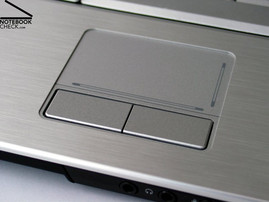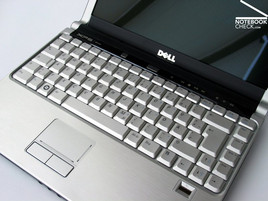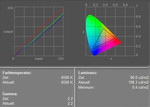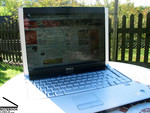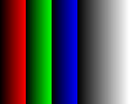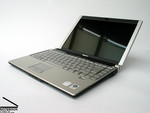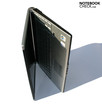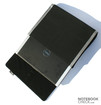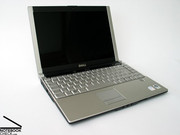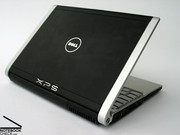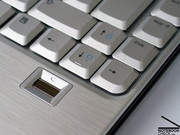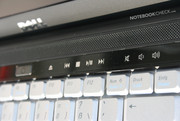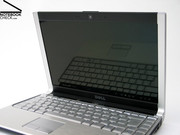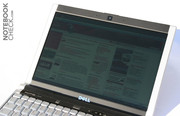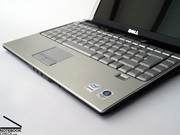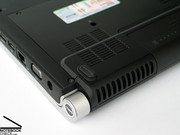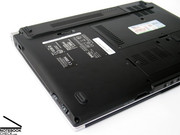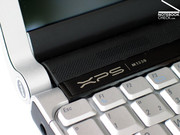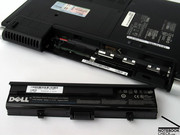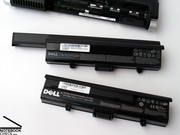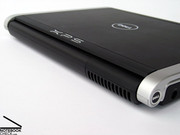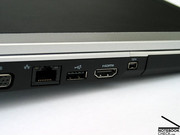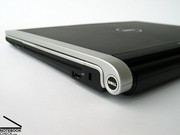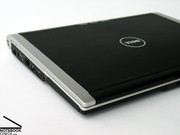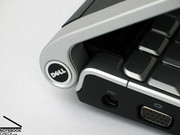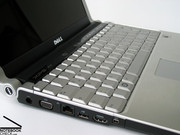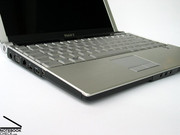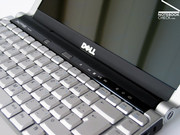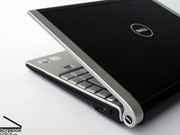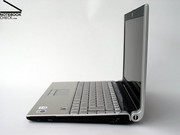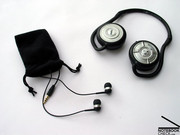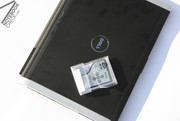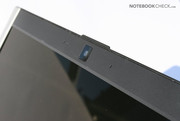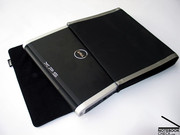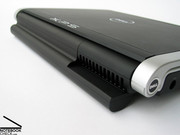Review Dell XPS M1330 Notebook
Power-Sub. If Dell launches a subnotebook which belongs to the XPS series, you should already know what you can expect. Right, first-class performance. Although the aesthetically pleasing case is not spacious, Dell was able to put a powerful T7300 CPU and a Geforce 8400M GS video card in. Combined with a 13.3" LED display this notebook is attractive.
Case
Dell added a notebook with completely new design to its product range, the XPS M1330. In contrast to many other Dell notebooks, the XPS M1330 scores points by an elegant form. Also the tapered front edge looks beautiful. However, the design of the hinges and the notebook's back side are crucial for the overall appearance of the notebook.
Regarding colors, the XPS M1330 has a black finished trough made of aluminum, roughened aluminum palm rest areas, and a black display with silver molding. The used materials and the slightly roughened surfaces contribute to the notebook's comfortable and high-quality haptics. The display cover is designed in the same way, but, very sensible to fingerprints and hard to clean.
Besides the design also the stability of the case convinces. The base unit is very flexural rigid and also very resistant against applied forces. Regarding this aspect, we could detect some smaller weaknesses above the keyboard, where especially the cover of the speakers can partly be easily pushed in. The same is true, for the complete part with the XPS logo, which even wobbles a little bit. Although the flexural rigidity is generally alright, also the display clearly yields under pressure.
The hinges of the Dell M1330 do not only look good, they also convince in use. The position of the display can be precisely adjusted, whereas no see-saw is noticeable.
A transport hook, i.e. a single or multiple hooks to secure the display in closed state, are missing. Instead a closing mechanism of the hinges, keeps the notebook closed. To prevent the risk of object penetration between display and base unit, Dell provides a notebook bag for the XPS M1330 instead. As long as you do not travel with big luggage, it is very useful. There even isn't enough space for the power adapter in this elegant cover. Fortunately, the XPS M1330 fits even with the clearly bigger 9-cell battery in.
As a supplement, you'll find stereo cable bound headphones and bluetooth headphones, which allow enjoying music without cable possible, in the package. The sound of both of these devices is acceptable.
Although it seems that the XPS M1330 provides only few interfaces at first, they are adequate considering it is a subnotebook. Besides the standard ports, i.e., LAN, modem, VGA, USB, also audio ports, a firewire port and a HDMI port are provided. Perhaps, you'll miss the docking port, which would be a very reasonable supplement for compact and mobile notebooks.
We think that this is maybe Dell's way to differentiate between consumer and business notebooks.
Input Devices
The keyboard of the Dell XPS M1330 nearly takes up the whole width of the case. So, the keyboard unit looks spacious. But, even at a closer look the keys are of good size and the layout is reasonable.
Typing with M1330 feels comfortable. It is possible to type a number of text pages without bigger problems. It is easy to hit the right keys, and also the point of pressure convinces. The key travel is short, but, yet adequate, typing feels soft and the point of pressure is somewhat less definitive. The keyboard is attached tightly. This is most obvious, because of the relatively hard stop at the end of the typing process.
Typing is not too loud. Even, if you type forcefully, the noise level stays acceptable all the time.
The touchpad has, typical for Dell, positive qualities. These are a user-friendly surface, optically marked scroll zones, and two touchpad buttons which are soft in use.
The molding with hotkeys is right above the keyboard and nicely designed by blue LEDs. When switching the notebook on, these are illuminated one after each other and show a 'KITT' effect, which got famous for its red running light in TV history.
Display
At the time of writing there are 2 different display versions available for the XPS M1330. First of all, a 13.3" panel which utilizes CCFL technology and comes with a resolution of 1280x800 pixels, and an equally big WXGA display with LED technology which costs about 190.- Euro more. Both display versions are called „TrueLife“, which stands for a reflecting surface.
The resolution of 1280x800 pixels fits well to the 13.3" display and provides an acceptable desktop size and at the same time a good font size. We felt that the display was subjectively rich in contrast and good regarding color representation.
The LED display of the reviewed Dell XPS M1330 scored points in our measurements. Its maximum brightness was 224.3 cd/m² in the lower left area. But the brightness diminishes to about 170 cd/m² at the top edge. So, the illuminaation is 76.6%, which is rather below-average. Similar to the Apple MacBook Pro the main advantages of the LED technology are low power consumption and a longer lifespan of the backlight.
| |||||||||||||||||||||||||
Brightness Distribution: 77 %
Contrast: 495:1 (Black: 0.4 cd/m²)
The measured black value, this is the minimum representable brightness, was very low. The excellent 0.4 cd/m² lead together with the maximum brightness to a brilliant maximum contrast ratio of 561:1. This should be the biggest advantage of the LED version.
The viewing angles of the reviewed panel are rather average. Vertically, when looking from top down, you'll quickly face a loss of contrast and a darkening of the display. If you fold the display to the back, you'll face a similar phenomenon. Additionally, we need to mention that the opening angle is limited to 140°.
Horizontally, you'll too face a loss of contrast and also clear reflections, if the angle gets acuter.
Video of Display's Viewing Angles
Performance
If Dell labels a notebook with XPS, nobody will expect to find a limited ULV (Ultra Low Voltage) or even a Core Solo processor in it. The same is completely true for the XPS M1330. Equipped with a Core 2 Duo T7300 CPU with 2.0 GHz and a NVIDIA Geforce 8400M GS video card with 128MB video memory it clearly outperforms a number of competitor subnotebooks.
Here you might legitimately question whether so much power is reasonable for a compact notebook. Be this as it may, obviously, there is a demand for notebooks which are configured alike the M1330, which should not be under- estimated. Additionally, there are still not too much competitor notebooks of this kind available nowadays.
You can be sure to be at the absolutely safe side even through the coming years, at least regarding office and multimedia applications. This might be an important aspect, which might influence your buying decision.
The benchmark tests showed good results for 3DMark and acceptable results for PCMark. We felt that the access time of the built-in 160GB harddisk was somewhat too low, and presumably also impeded a higher PCMark result.
Despite of a good performance, something has to be clear: Good multimedia performance does not mean that games can be played without limitations. This is also true for the Dell XPS M1330. Doom 3 and Fear run fine with low resolution and details, however, if you increase them, the built-in video card is quickly at its limit. Especially with new computer games, the XPS quickly reaches its performance limits.
| 3DMark 2001SE Standard | 13585 points | |
| 3DMark 05 Standard | 3168 points | |
| 3DMark 06 1280x800 Score | 1447 points | |
Help | ||
| PCMark 05 Standard | 3941 points | |
Help | ||
| Doom 3 | |||
| Resolution | Settings | Value | |
| 1024x768 | Ultra, 0xAA, 0xAF | 36.5 fps | |
| 800x600 | High, 0xAA, 0xAF | 59.8 fps | |
| 640x480 | Medium, 0xAA, 0xAF | 100.3 fps | |
| 640x480 | Low, 0xAA, 0xAF | 98.3 fps | |
| F.E.A.R. | |||
| Resolution | Settings | Value | |
| 1024x768 | GPU: max, CPU: max, 0xAA, 0xAF | 15 fps | |
| 800x600 | GPU medium, CPU medium, 0xAA, 0xAF | 55 fps | |
| 640x480 | GPU min, CPU min, 0xAA, 0xAF | 300 fps | |
| Quake 3 Arena - Timedemo | |||
| Resolution | Settings | Value | |
| 1024x768 | highest, 0xAA, 0xAF | 199.1 fps | |
Emissions
Loudness
Despite the fan runs permanently even in idle mode, we felt that the XPS is relatively quiet. This is mainly because of the low-frequency noise, which is rather decent, despite of a noise level of 35.4 dB with office applications. Sometimes, the fan runs even in idle mode at higher revolutions, which lets the notebook appear a little louder, but, in total the noise is acceptable.
Sometimes a high-frequency cheeping can be heard in idle mode, but, only if the environment is absolutely quiet and when listening very carefully. Furthermore, we, would not call it annoying.
A clicking noise is sometimes emitted by the hard disk, especially during the boot process.
Under load the fan runs clearly faster, and a noise level of about 42.9 dB is reached. Sometimes we also measured annoying maximum values of 47.2 dB. During standard usage, it is not very likely that this noise level is reached. But, if it was, we have to mention, that the fan immediately decelerates, if the performance demand falls. So, the noise level will be acceptable again soon.
Noise level
| Idle |
| 0 / 35.4 / 0 dB(A) |
| HDD |
| 36.4 dB(A) |
| DVD |
| 38.9 / dB(A) |
| Load |
| 42.9 / 47.2 dB(A) |
 | ||
30 dB silent 40 dB(A) audible 50 dB(A) loud |
||
min: | ||
Temperature
Our test uncovered that the surface temperature in idle mode were nearly above the ones under load. Especially the temperature of the palm rest areas, made of aluminum, was comfortable, because it did not exceed 32.8°C. The maximum of the top side was measured in touchpad region and amounted to 35.5°C.
The surface temperature of the bottom side was somewhat higher than at the top side. We measured a maximum of up to 38.2°C, which is also acceptable and allows a use at the top of the lap.
Apropos use at the lap: The suction hole of the fan is at the back left side of the bottom side and you should take care not to cover it with anything, especially when demanding high performance at the same time. Still, also mobile use on soft surfaces was trouble-free.
(+) The maximum temperature on the upper side is 35.5 °C / 96 F, compared to the average of 35.9 °C / 97 F, ranging from 21.4 to 59 °C for the class Subnotebook.
(+) The bottom heats up to a maximum of 38.3 °C / 101 F, compared to the average of 39.3 °C / 103 F
(+) The palmrests and touchpad are reaching skin temperature as a maximum (35.5 °C / 95.9 F) and are therefore not hot.
(-) The average temperature of the palmrest area of similar devices was 28.2 °C / 82.8 F (-7.3 °C / -13.1 F).
Speakers
The sound of the two speakers, located beneath a perforated cover above the keyboard, is average. Especially the basses are not so good. The maximum volume is also only moderate.
Sound output via the 3.5mm stereo plug is without any anomalies or disturbing ambient noise. Digital sound is available via the provided HDMI port with proper adapter.
Battery Runtime
The Dell XPS M1330 notebook is available with three batteries of different capacity. Besides the 4- and 6-cells batteries, which fit entirely into the notebook, also a clearly bigger 9-cells battery, which clearly protrude the case and also increase the weight by about 170g compared to the 6 cells version, is available.
For mobility you should definitely at least choose the 56Wh 6 cells version. The runtime was also measured with a battery of this kind.
The 4 cell versions is only for those who like very light notebooks, if weight is the most important aspect. For those who travel a lot the 9-cells 85Wh battery might be interesting too. Its runtime should be about 50% longer than the one of the 56Wh battery. The cost of 47,60.- EUR, at the time of writing, should also be alright.
If you use the Dell XPS M1330 with the bigger 9-cells battery the notebook will stand gently inclined. Interestingly, this also improves the typing comfort.
The runtime of the 56Wh Akkus ranged from a minimum of somewhat about one hour to a maximum of a little above 5 hours. During DVD playback the runtime of the XPS was 150 minutes, which should be sufficient for most movies. Even the runtime during WLAN usage, in energy saving mode, brightness at level 6 (one below maximum, display still good legible) of about 3 hours is rather passable.
You can estimate the runtime of the other battery solutions, by subtracting 50% (4 cells, 37Wh), respectively adding 50% (9 cells, 85Wh).
| Off / Standby | |
| Idle | |
| Load |
|
Key:
min: | |
Verdict
Overall the Dell XPS M1330 can be called a special notebook which provides nearly everything one might expect from a subnotebook, without having considered the necessity of these demands in advance.
Sure, a small stylish notebook with brilliant display which is fit for games and at the same time quiet and provides a long battery runtime, would be fantastic. Moreover, it should also be completely fit for outdoor usage. Still desires? Of course, the price should not exceed 1000,- Euro. Clearly, these demands are far away from reality, but, the Dell XPS is yet very close to this desired configuration.
The case of the M1330 is beautifully designed and convinces also by high quality materials with user-friendly haptics. The stability is, besides of the relatively thin and pressure sensitive display, also good.
The input devices, i.e., keyboard and touchpad are user-friendly and fit for intensive use. The Dell XPS M1330 can also be well used without mouse or external keyboard, which would completely use up the two available USB ports. In turn, this notebook provides an HDMI port, so, its better off than some of the possible competitors of the business notebook class. Apropos business, a docking port might have been a reasonable supplement for the compact XPS.
The display, a 13.3 inch LED Panel is good and provides good brightness and brilliant contrast. Unfortunately the XPS is only available with reflecting panels, so, outdoor usage is limited.
The performance of the XPS M1330 is compared to competitor notebooks of the subnotebook class really excellent. Even, if you only utilize a small portion of the available performance, it's good to know, that there are sufficient reserve capacities. However, the provided equipment is still somewhat too weak for demanding games.
The emissions are especially during office mode acceptable and hardly annoying. Although the fan has to speed up under load in order to provides the powerful hardware with sufficient air, the noise emissions are in total still alright.
Even the battery runtime of the Dell XPS M1330 is, despite powerful hardware equipment, alright. The 6 cells battery provides a good runtime of up to 5 hours. Equipped with the bigger and heavier 9-cells battery, the expected runtime is even higher.
For fans of XPS, also accessories like different bags and headsets are available. Furthermore, the notebook is equipped with a web cam, with either 0.3 or 2.0 Megapixel resolution (depending on the chosen display version), and a fingerprint reader.
Addendum
During the first test the notebook got noticeable hot and the fan stayed turned off. We tried to solve the problem by reinstalling Windows Vista. But, this installation did not complete successfully, because the notebook shutdown by itself. At an on-site service (which ran smoothly) where main board and the whole cooling solution were exchanged, we could get some insights of the Dell XPS M1330. Here are some pictures of it.









